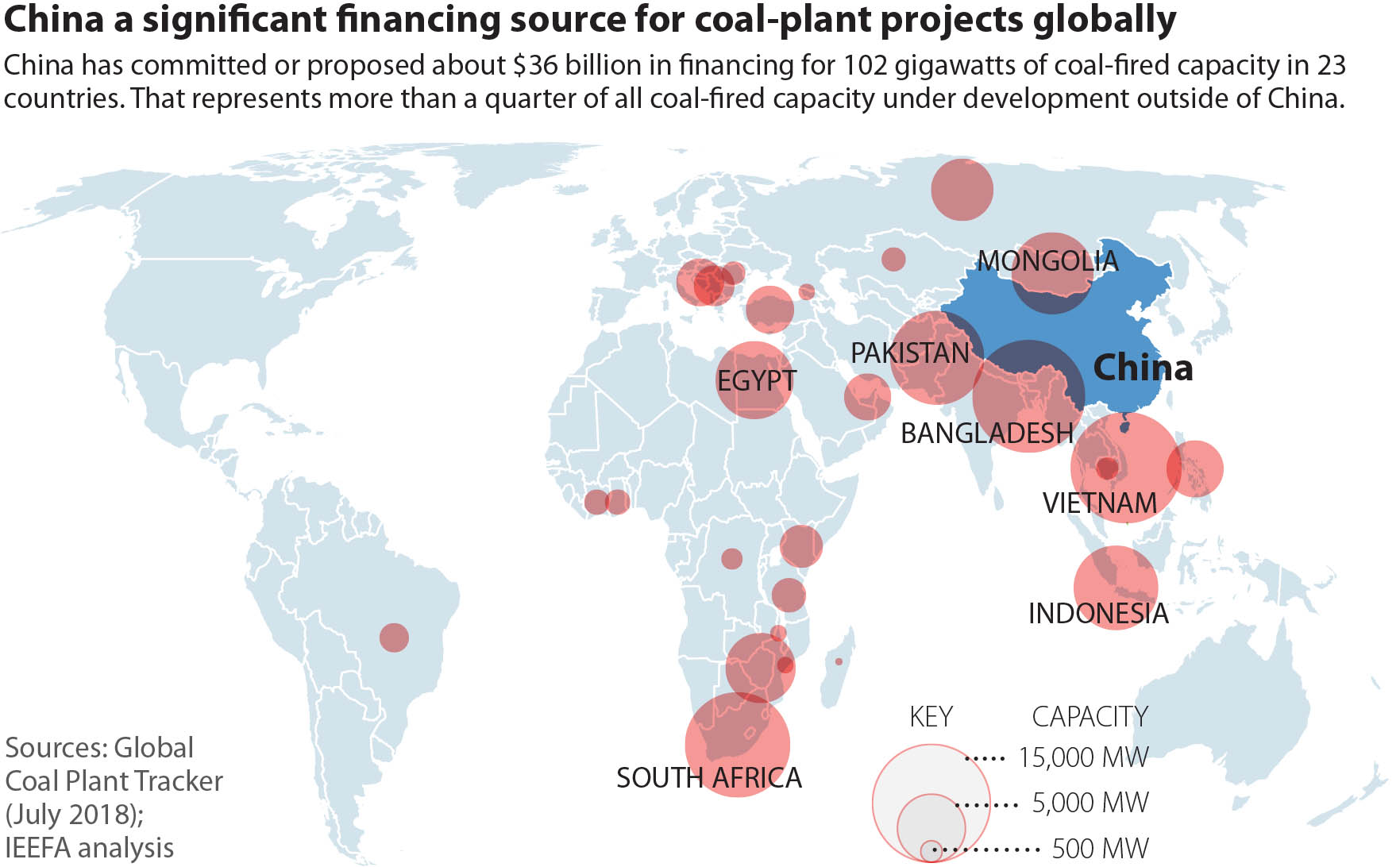China is not only building coal-fired plants in its own country, but it is also building them around the world. As of 2019, China had 2,363 active coal-fired power plants and was building another 1,171 plants in China and hundreds more in Africa, Asia and elsewhere. Most of China’s plants (80 percent) have pollution control equipment that remove sulfur dioxide, nitrogen oxides and particulates, but the coal plants China is building in Africa and most likely elsewhere do not. And none of the plants China is building remove carbon dioxide despite China pledging it will be carbon neutral by 2060. Coal plants can operate for 40 to 60 years or even longer. China’s party leaders know that its so-called production of renewable generating technologies, many of which are not connected to the grid, is a good smokescreen for its coal power—and few Western governments will dare to criticize China. Clearly, President-Elect Biden will not criticize China either.
Worldwide Coal Builds
China has invested over $50 billion in building new coal plants overseas in recent years. It is purportedly building, planning or financing more than 300 coal plants, in Turkey, Egypt, Vietnam, Indonesia, Bangladesh, and the Philippines. India, South Korea, Japan, South Africa and even Germany are also building hundreds of coal-fired power plants. Over a quarter of new coal plants outside China have some commitment or offer of funds from Chinese financial institutions. China is subsidizing investment in coal plants across 27 countries, while supplying the United States and Germany with renewable technologies that are cheaper than their countries can manufacture. Further, China has positioned itself well in the supply chain for critical metals and rare earth minerals.

While China is building coal plants around the world, the United States is shuttering its coal-fired power plants, despite having—by far—the world’s largest supplies of coal. Between January 2017 and May 2019, the United States shuttered 50 coal-fired power plants, with 51 more shutdowns announced, bringing the total shutdowns to 289 since 2010. As of October 2020, coal capacity in the United States totaled 221 gigawatts.
China’s leaders are seeking global military and economic power. They first intend to gain global control of electricity generation; raw materials extraction; and manufacturing of wind turbines, solar panels and battery modules, which they sell at low cost to the West.
Africa Needs Electricity
China is funding coal plants in Africa and elsewhere because the West will not fund coal projects, despite having an open field to invest and spread their influence. Clearly, coal-fired electricity from plants with scrubbers would eliminate pollution from dung and wood fires, and provide reliable, affordable electricity for lights, refrigerators, schools, shops, hospitals, and factories. Only a third of Africans have access to reliable electricity at home. Africa must industrialize to overcome poverty and disease, create jobs and discourage terrorism and to do that, it must have affordable, reliable electricity. Africa is projected to double its electricity capacity in the next 20 years.
With 1.1 billion people, Sub-Saharan Africa remains the world’s poorest region, despite massive mineral resources and a young, energetic population with an affinity for entrepreneurship. Africa is home to four of the world’s top 20 crude oil producers (Nigeria, Angola, Algeria, and Libya) and Algeria and Nigeria are among the top 20 natural gas producers. Mozambique also has huge natural gas reserves. But, U.S., EU, UN and World Bank policies oppose Africans using the continent’s abundant coal and natural gas to fuel power plants, because carbon dioxide from fossil fuels might exacerbate climate change. Despite that, analysts believe that Africa’s cheap, abundant, easily transportable coal will continue to be used on a large scale for electricity generation. And, it leaves construction of coal plants to China and others who have scrubbing technology but do not require it in their foreign construction.
In much of Africa, electricity demand far outstrips supply. When the grid goes down, expensive back up diesel generators are used. Many African countries spend more on backup power than on electricity for the grid itself. In West Africa, backup power equals 40 percent of total grid capacity. In Sudan, which gets 30 percent of its energy from dams on the Nile River, diesel-based pumps run constantly to lift river water for irrigation. In Nigeria, hotels ban guests from jogging because of health dangers from breathing soot from their diesel backup generators, which operate frequently when the power goes dark.
Africa’s electricity deficit translates directly into its life-expectancy deficit of 15 years per person.
Conclusion
China will continue to get a total pass on complying with the Paris accord and will continue to build coal plants in Asia and Africa, many of which operate without scrubbing equipment. Thus, China will have free rein to turn sub-Saharan Africa into an archipelago of economic dependence, despite the environmental damage, debt, labor concerns, and likely modest benefits to Africans that will result. Further, under a Biden Administration, the United States will rejoin the Paris Agreement and continue to shutter U.S. coal plants to attain carbon neutrality in the generating sector by 2035, while much of the rest of the world will be allowed to continue to emit greenhouse gas emissions from coal generating plants and other carbon sources. Yet, until the media begins to actually report the facts about China’s activities, most Americans will be unaware of the rapidly growing gap between words and actions as they apply to China’s quest to be the number one economy in the world.



